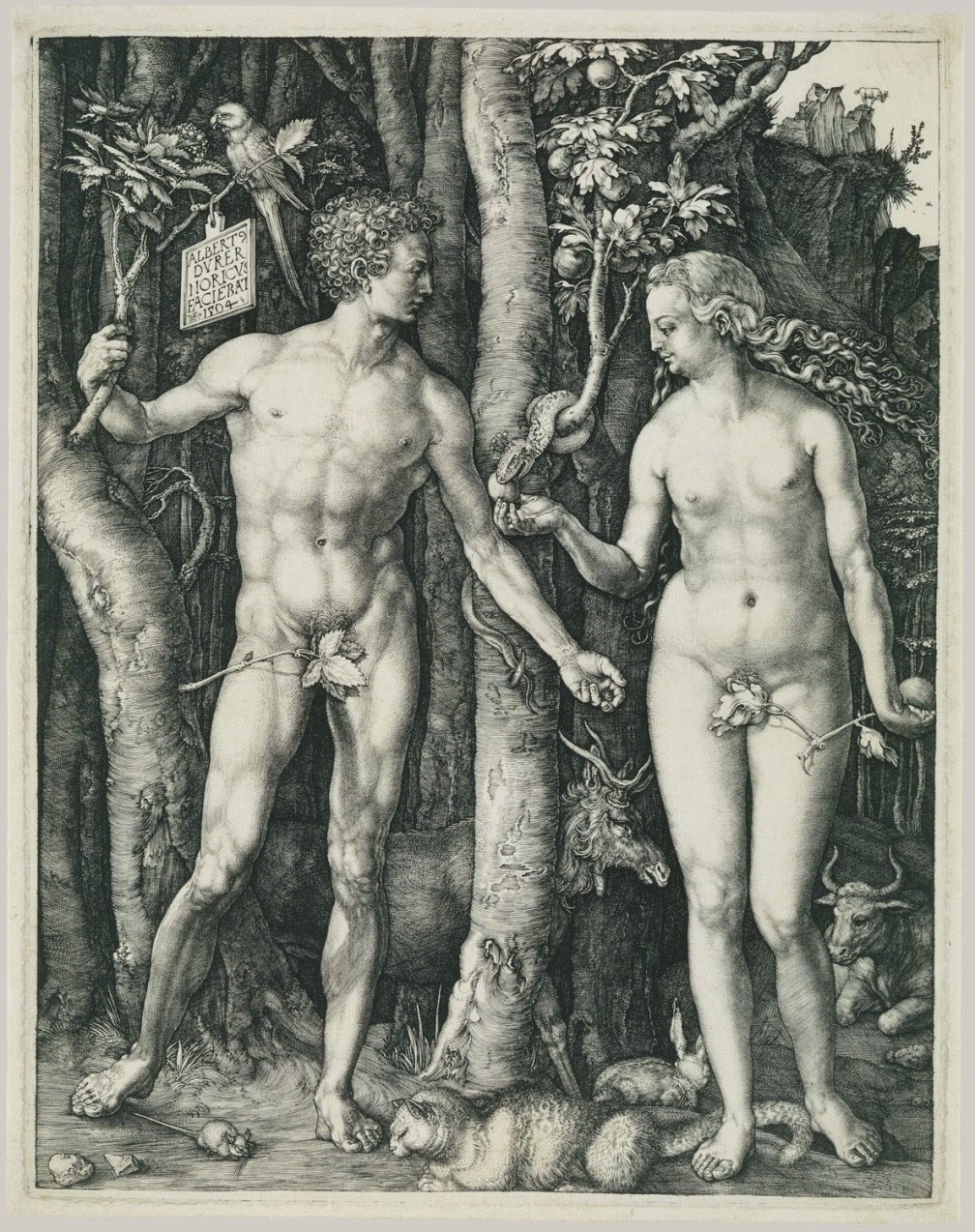
For the Renaissance period I chose to focus on Albrecht Durer, and his engraving of “Adam and Eve,” created in Nuremburg at the end of Durer’s life in 1504.
The story of Adam and Eve is fairly well known, even to those who are not very familiar with religious texts and teachings (like myself). Durer’s depiction has several attention grabbing features; next to Eve’s face is the serpent, with what looks to be the apple from the tree of knowledge. Eve and Adam are also posed in a symmetrical manner; their weight on one foot, one arm down and one arm grabbing an object, as well as their bodies being turned slightly towards each other.
My reaction to the piece centered on its religious message. It was easy to place the story of Adam and Eve, and just as easy to identify and remember the significance of the snake and the apple. The black and white theme of the piece seemed to invoke a very serious tone, accentuating the importance of the scene – almost as if it was light and dark in the same image, Adam on one side trying to uphold virtue with Eve on the other side about to succumb to the serpent and the fruit from the Tree of Knowledge. The animals and the deep forest setting illustrating the Garden of Eden as the background.
According to Khan Academy, all six of the animals that make an appearance have a symbolic meaning. The parrot, thanks to its call being interpreted as “Eve-Ave,” is supposed to be a word play for “Eve and Ave Maria,” or the Hail Mary, characterizing the Virgin Mary and the antidote for Eve’s sin in the Garden of Eden. The snake symbolizing Eve’s sin. The other four, the elk, ox, rabbit, and cat are supposed to represent the four human personality types – melancholic, phlegmatic, sanguine, and choleric, respectfully. The Khan Academy goes on to explain that after the fall, due to Eve’s sin, one personality type reigned over each person, and that this representation of all four personality types coupled with Adam and Eve’s balanced posing is meant to illustrate a moment of complete harmony in the Garden. “The cat is not yet chasing the mouse.” (Khan Academy)
Durer’s portrayal of Adam and Eve in his portrait of the same title are was also very humanistic. “Adam and Eve are examples of a humanist conception of the body. They are endowed with autonomy and dignity, and their forms reflect Dürer’s ideal of beauty.” (NYU School of Medicine) The prime importance of the piece lies in the human features, rather than a divine appearance to portray the religious aspects. “Albrecht Durer was, in effect, the first non-Italian artist to associate the humanistic disciplines with the esthetic pursuits of art.” (New World Encyclopedia)
Works Cited
The shear amount of detail in this piece is impressive. From the detail of the background to the detail in the animals, humans, and environment. The amount of contrast to help depict depth is very helpful visually. There is more realism with the use lines, shadows, and linear perspective which was very popular at the time. Durer was in Italy at this time 1502 to 1507 and with humanism being very popular, there is no surprise that it made such an appearance in this piece. For my blog I also looked at Durer as well, but I looked at one of his prints of a rhinoceros and he uses some of the same techniques to draw all of his animals and they all have a beautiful amount of detail that was used for humanism. I am glad to see that humanism did not just effect art revolving around humans but also animals.
What do you think the goat in the background on the cliff symbolizes? It is a bit hard to see and at first I though that it was just a part of the background, but after further inspection it was an animal. With each animal representing something, I am curious as to what the goat could mean. After doing some research I did find a site that listed what each animal meant. The goat is a symbol of lust and damnation which I find interesting with it being on a cliff so far away. What do you think that means in terms of the context of the print?
http://www.clarkart.edu/exhibitions/durer/content/symbolism-adam-eve.cfm
LikeLike
I liked your comments about the stance and posture of the figures. The renaissance was the first period in which artists really focused on perfecting the human form. Artists like Da Vinci and Michelangelo set the standard for anatomically correct depictions of the human form. This is very well presented in the piece you chose. The musculature, stance and form is extraordinarily realistic. This piece is a good representation of the way that art and depictions of the human form changed with humanism.
LikeLike